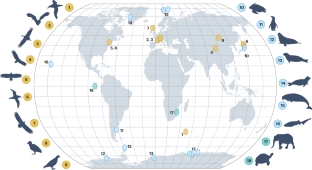電子の流れを可視化することで、飛行機の翼に着想を得た新デバイスの動機付けを得る Visualizing electron flow motivates new devices inspired by airplane wings
2023-09-19 カリフォルニア大学リバーサイド校(UCR)
◆研究チームは電子の流れを可視化するための新しいデバイス「電気翼」を設計し、光線を使用して電流の流線を観察しました。電子の熱は回路の損傷を引き起こす可能性があるため、電子の流れ方を正確に知ることは重要です。この技術は、電子デバイスの設計においてどこで熱が発生するかを評価し、設計上の改善点を示唆するのに役立つ可能性があります。
<関連情報>
- https://news.ucr.edu/articles/2023/09/19/electrons-take-flight-nanoscale
- https://www.pnas.org/doi/10.1073/pnas.2221815120
マイクロマグネティックヘテロ構造デバイスを介した固有の光電流ストリームラインのマッピング Mapping the intrinsic photocurrent streamlines through micromagnetic heterostructure devices
David Mayes, Farima Farahmand, Maxwell Grossnickle, Mark Lohmann, Mohammed Aldosary, Junxue Li, Vivek Aji, Jing Shi, Justin C. W. Song and Nathaniel M. Gabor
Proceedings of the National Academy of Sciences Published:September 18, 2023
DOI:https://doi.org/10.1073/pnas.2221815120

Significance
Direct imaging to track photocurrent streamlines in quantum optoelectronic devices remains a key challenge in understanding exotic device behavior. Here, we combine laser imaging with light-sensitive devices to show images of photocurrent streamlines through a working device. We design a type of device called an electrofoil that allows us to contort, compress, and expand these photocurrent streamlines in a similar way to wings, which contort, compress, and expand the flow of air. With imaging resolution spanning over an order of magnitude in spatial scale, we have shown that photocurrent streamline microscopy is a robust experimental tool for obtaining detailed visualization of photocurrent in quantum materials.
Abstract
Photocurrent in quantum materials is often collected at global contacts far away from the initial photoexcitation. This collection process is highly nonlocal. It involves an intricate spatial pattern of photocurrent flow (streamlines) away from its primary photoexcitation that depends sensitively on the configuration of current collecting contacts as well as the spatial nonuniformity and tensor structure of conductivity. Direct imaging to track photocurrent streamlines is challenging. Here, we demonstrate a microscopy method to image photocurrent streamlines through ultrathin heterostructure devices comprising platinum on yttrium iron garnet (YIG). We accomplish this by combining scanning photovoltage microscopy with a uniform rotating magnetic field. Here, local photocurrent is generated through a photo-Nernst type effect with its direction controlled by the external magnetic field. This enables the mapping of photocurrent streamlines in a variety of geometries that include conventional Hall bar-type devices, but also unconventional wing-shaped devices called electrofoils. In these, we find that photocurrent streamlines display contortion, compression, and expansion behavior depending on the shape and angle of attack of the electrofoil devices, much in the same way as tracers in a wind tunnel map the flow of air around an aerodynamic airfoil. This affords a powerful tool to visualize and characterize charge flow in optoelectronic devices.



